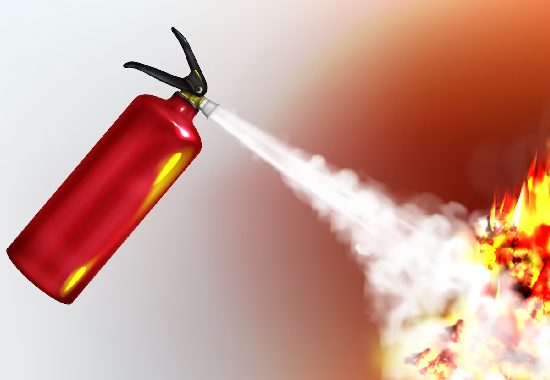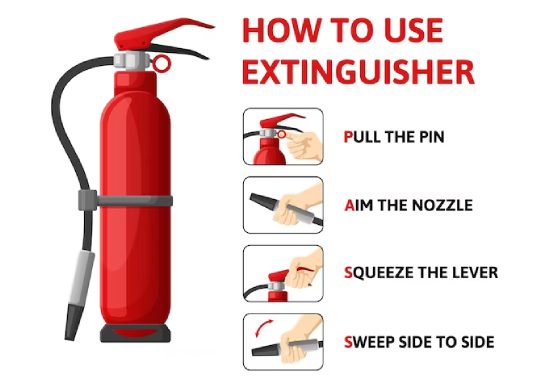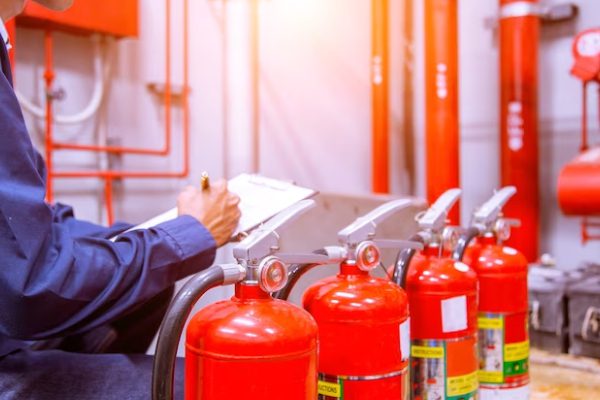The Different Types of Fire Extinguishers and What They’re Used For

Is Cementitious Fireproof Coating?
February 28, 2023
Fire Alarm Systems: Your Guide to Safety and Security
July 8, 2023Fire extinguishers are essential fire safety equipment that can help to put out small fires before they get out of control. There are many different types of fire extinguishers available, each with its own unique properties and uses.
The different types of fire extinguishers are classified according to the class of fire that they are designed to extinguish. There are five classes of fire:
- Class A: Ordinary combustible materials, such as wood, paper, and fabric
- Class B: Flammable liquids, such as gasoline, oil, and paint
- Class C: Flammable gases, such as propane and butane
- Class D: Combustible metals, such as magnesium and sodium
- Class K: Cooking oils and fats
Water Fire Extinguishers
Water fire extinguishers are the most common type of fire extinguisher. They are effective at extinguishing Class A fires, which are fires that involve ordinary combustible materials. Water extinguishers work by cooling the fire and reducing the amount of oxygen available.
Water fire extinguishers are not effective at extinguishing Class B or Class C fires. Water can conduct electricity, so it should not be used on electrical fires. Water can also spread a fire involving cooking oils or fats.
Foam Fire Extinguishers
Foam fire extinguishers are also effective at extinguishing Class A fires. They work by smothering the fire and preventing oxygen from reaching it. Foam extinguishers are also less likely to spread a fire than water extinguishers.
Foam fire extinguishers can be used on Class B fires, but they are not as effective as dry powder or carbon dioxide extinguishers. Foam extinguishers should not be used on electrical fires.
Dry Powder Fire Extinguishers
Dry powder fire extinguishers are effective at extinguishing Class A, Class B, and Class C fires. They work by smothering the fire and chemically interrupting the combustion reaction. Dry powder extinguishers are a good choice for general-purpose use, but they can be messy and difficult to clean up. They should not be used on electrical fires, as the powder can conduct electricity.
Carbon Dioxide (CO2) Fire Extinguishers
Carbon dioxide (CO2) fire extinguishers are effective at extinguishing Class B and Class C fires. They work by displacing oxygen and cooling the fire. CO2 extinguishers are a good choice for fires involving electrical equipment, as they do not conduct electricity. However, they should not be used on Class A fires, as they can spread the fire.
Wet Chemical Fire Extinguishers
Wet chemical fire extinguishers are effective at extinguishing Class K fires, which are fires involving cooking oils or fats. They work by breaking down the oil or fat into smaller particles that are less likely to burn. Wet chemical extinguishers are a good choice for kitchens, but they should not be used on other types of fires.
Other Types of Fire Extinguishers
In addition to the types of fire extinguishers mentioned above, there are a few other types that are available. These include:
- Purple K fire extinguishers: These extinguishers are effective at extinguishing Class D fires, which are fires involving combustible metals.
- Halon fire extinguishers: These extinguishers were once widely used, but they have been phased out due to their environmental impact.
- Clean agent fire extinguishers: These extinguishers use a variety of chemicals that are non-toxic and environmentally friendly.

How to Choose a Fire Extinguisher
When choosing a fire extinguisher, it is important to consider the following factors:
- The type of fire that the extinguisher is most likely to be used on
- The size of the fire extinguisher
- The weight of the fire extinguisher
- The ease of use of the fire extinguisher
- The cost of the fire extinguisher
It is also important to make sure that the fire extinguisher is properly labeled and maintained. The label should indicate the type of fire that the extinguisher is effective on, as well as the expiration date of the extinguisher. The fire extinguisher should also be inspected regularly to make sure that it is in good working order.
How to Use a Fire Extinguisher
If you find yourself in a fire, it is important to stay calm and use the fire extinguisher as instructed. Here are the basic steps on how to use a fire extinguisher:
- Pull the pin on the fire extinguisher.
- Aim the nozzle of the fire extinguisher at the base of the fire.
- Squeeze the handle of the fire extinguisher to discharge the extinguishing agent.
- Sweep the nozzle from side to side, at the base of the fire, until the fire is out.
- Stand back and assess the situation. If the fire is still burning, call the fire department.
- Never use a fire extinguisher if you are not sure how to use it.

Fire Extinguisher Maintenance
Fire extinguishers should be inspected regularly to make sure that they are in good working order. The inspection should include the following:
- Checking the pressure gauge to make sure that the extinguisher is fully charged
- Inspecting the hose and nozzle for damage
- Checking the label to make sure that the extinguisher is still effective for the type of fire that it is labeled for
Fire extinguishers should also be recharged or replaced according to the manufacturer’s instructions.
Conclusion
Fire extinguishers are an essential fire safety tool that can help to put out small fires before they get out of control. However, it is important to choose the right type of fire extinguisher for the job and to use it properly. By following the safety tips and maintenance guidelines discussed in this article, you can help to ensure that your fire extinguisher is always ready to use in the event of a fire.
If you need help choosing, inspecting, or maintaining your fire extinguishers, please contact us today at sales@ceasefireme.com. We offer a variety of fire extinguisher services, including installation, inspection, maintenance, and repair. We can help you choose the right fire extinguishers for your needs and ensure that they are always in good working order.

